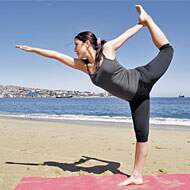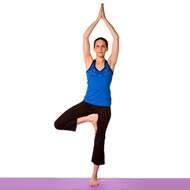What is the secret to doing arm balance poses better?
This is because unlike the legs, the arms are not built to support our body's weight. However, when we force our arms to support the weight of our body, it provides a number of benefits.
Mastering arm balance poses is not easy.
There are a number of arm balance poses, and even the simple ones like the Staff Pose (Dandasana) and the plank pose are difficult. These poses are common, however, and the Staff Pose, for example, is very similar to the push up position.
Problems arise when you want to get into more difficult poses. The side plank pose (Vasistasana) not only calls for arm strength but also deep relaxation. One side of your body needs to be stiff in order to support the weight of your body, but the other needs to be relaxed so that you don't topple forward or backward. The upward plank pose (Purvottanasana) is also similar. It is not especially difficult, but you need a certain amount of strength in your arms and back in order to do it, and this comes only after a few months of doing yoga regularly.
Poses such as the Crane Pose (Bakasana) and Eight Angle Pose (Astavakrasana) are the really tough ones. In these poses, your entire body weight is on your hands, and there is no other part of the body other than your palms that is in contact with the floor. These poses require that you have a calm mind and will power in order to master them. In fact, both these poses are supposed to develop powers of concentration and will for this very reason. The amount of strain on the arms and back are tremendous and only long time practitioners are recommended these poses.
Following the steps makes it easy to get into these poses, but there is no simple way to do these poses. You need to have strong enough arms to support your weight, and concentrate hard because if not you cannot hold the pose for more than a couple of seconds at the most. Developing required skills is not easy, and long and persevering practice is needed. However, the benefits of arm balance poses are huge. They invigorate your entire body because you are forcing your body to stand on limbs that it is not called on to do. This not only develops your body, but your mind too, because it calls upon your brain to concentrate on doing something that you can usually do without though at other times – balance.
References
- http://www.ncbi.nlm.nih.gov/pubmed/22973410
- http://dmc122011.delmar.edu/kine/CarolynPosesAndAlignmentCues.html
Read more articles from the Yoga Asana Benefits Category.

 Find Pose
Find Pose

